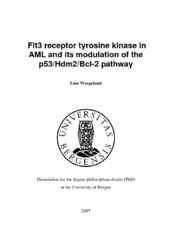| dc.contributor.author | Wergeland, Line | en_US |
| dc.date.accessioned | 2007-11-27T12:21:42Z | |
| dc.date.available | 2007-11-27T12:21:42Z | |
| dc.date.issued | 2007-09-06 | eng |
| dc.identifier.isbn | 978-82-308-0417-9 (print version) | en_US |
| dc.identifier.uri | https://hdl.handle.net/1956/2453 | |
| dc.description.abstract | Acute myeloid leukemia (AML) is an aggressive disease with a poor overall survival rate. The most frequent mutations associated with AML are internal tandem duplications (ITD) in the juxtamembrane region of the receptor tyrosine kinase Flt3. These mutations render the receptor constitutively active and alter signaling trough FLT3-ITD compared to wild type receptor. Non-mutated TP53 and elevated expression of its regulator Hdm2 is another interesting feature of AML. Studies have shown that the p53 pathway can be linked to Flt3 signaling as a subset of FLT3-ITD patients expresses increased levels of the anti-apoptotic protein Bcl-2 and hyperphosphorylated p53 protein. This thesis investigates the properties of FLT3-ITD and the interconnection of the Flt3 signaling pathway with the p53/Hdm2/Bcl-2 pathway in an attempt to elucidate novel therapeutic targets in AML. The experiments demonstrate a reciprocal regulation of Flt3 and Hdm2 in AML cells with Flt3-wt while FLT3-ITD cells suspend the Hdm2 modulation. FLT3-ITD patient cells have a higher level of Flt3 protein and the ITD results in dysregulated receptor turnover and attenuated Hdm2 down-regulation. Thus targeting of FLT3-ITD may result in elevated Hdm2 and increased tolerance for p53. The involvement of Bcl-2 family of proteins is also seen in this setting; a persistent attenuation of Mcl-1 is required for the cells to undergo apoptosis, however this is only seen in Flt3-wt cells. Hdm2 is in addition shown to be important as a regulator of Bcl-2. The blockage of Hdm2 E3 ligase activity results in increased Bcl2 and Hdm2 is required for Bcl-2 protection from p53-induced cell death. To conclude, wild type and mutated Flt3 is interconnected with the important p53/Hdm2/Bcl-2 pathway at several levels. Therapeutic targeting of Flt3 should therefore be evaluated in co-operation with the p53/Hdm2/Bcl-2 pathway. Combined targeting of FLT3-ITD, Hdm2 and Bcl-2 may therefore be interesting when approaching the development of novel AML therapy. | en_US |
| dc.language.iso | eng | eng |
| dc.publisher | The University of Bergen | eng |
| dc.title | Flt3 receptor tyrosine kinase in AML and its modulation of the p53/Hdm2/Bcl-2 pathway | en_US |
| dc.type | Doctoral thesis | |
| dc.subject.nsi | VDP::Medisinske Fag: 700::Klinisk medisinske fag: 750::Hematologi: 775 | nob |
